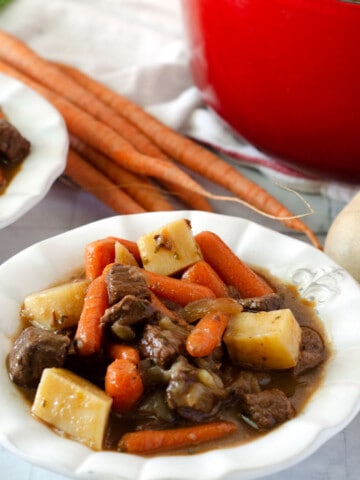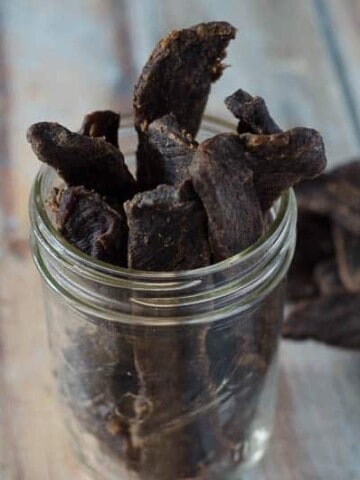Ever wondered what the difference is between grass fed and grass finished beef? They might not mean what you think they mean. Here's what they mean and how to choose!

One of the first things I learned when trying to learn more about what I was eating was to not take labels at face value. Often things they slap on the front of packages make big claims, but don't carry a lot of weight. Things like "low fat" and "no added sugar" often just translate to added chemicals and fake sweeteners that are just as bad, if not worse, for you than the original.
It seems like meat would be more straightforward, but these days it's not. In my Ground Beef Guide, I go over the different cuts and types of ground beef, depending on fat content and flavor.
But what about the other labels you see on beef, about what that cow was fed? What does grass-fed beef mean, really, and how is it different from a grass-finished beef? And what about grain-fed beef, and grain-finished beef? Most importantly - why does it even matter what the dang cow ate? Aren't you just eating the cow?
Yes and no. You are what you eat - but you are also what you eat eats. If that cow ate grain, you are now eating grain. If it ate grass, you're eating grass. So let's dive in to the different wordings on beef labels here (Spoiler: they are probably different than what you assume!)
Cattle (like sheep, deer and other grazing animals) are ruminants with the ability to convert grasses into flesh that humans can digest. Cattle can live off grasses because they have a rumen: a 45 or so gallon fermentation tank that converts cellulose into protein and fats – delicious meat.
Grain fed beef
This one is pretty straight forward. Grain-fed beef comes from grain-fed cows.
That said, grain-fed cattle do start their lives eating grass! Grain-fed cattle spend their last half-or-so of their lives being fattened or ‘finished’ in feedlots feeding on some types of grains, most often corn or soy.
This kind of feed is nothing near natural to these types of animals who are ruminants not created to feed on grain. The consequence for the animal is that their whole gastrointestinal system changes - and thus changes the nutritional composition of the meat that ends up on our plates.
Grain-fed beef has more of the saturated fats that are harmful to people’s health. Also, the meat has almost none of the helpful omega-3 fat that you would get from grass-fed beef.
Grass fed beef
When you see grass-fed on the label at the grocery store, you automatically think that the cow just ate grass, right?
Wrong. Grass-fed cows are not required to have a full grass-fed diet in order to get the grass-fed label on your beef’s packaging. Moreover, “grass-fed” cows are not necessarily pasture-raised.
Grass-fed can be used to label meat from cattle that were started on a grass diet but have either received supplemental grain feed or are finished on a fully grain-based diet. In fact, many “grass-fed” cows spend the last few months of their lives eating grain in feedlots to help them quickly gain weight, and they are a "grass fed" but also a grain-finished animal.
Grass finished beef
Simply put, grass-finished beef comes from grass-finished cattle that ate nothing but grass and forage for their entire lives.
All cattle eat grass. If you want to buy grass fed beef from cattle that have spent their entire lives eating only grass, make sure you’re getting “grass finished beef”.
Since all beef cattle are started on grass, they can technically claim that the animal was a grass-fed cattle regardless. But grass-finished cattle are the ones who both start and end on grass and nothing else.
There are several reasons to choose 100% grass-fed, grass-finished beef, including a number of significant health benefits. Grass-finished beef is 20% lower in calories than grain-finished beef and has higher levels of Omega-3 fatty acids, CLA’s (Conjugated Linoleic Acid — an essential fatty acid that fights cancer and inhibits body fat), and Vitamins A and E.
Is Organic beef also grass-fed?
Unlike conventionally-raised cattle, 100% grass-fed cattle must have access to pasture their entire lives and be only pasture- and forage-fed (with no grain).
But as with conventional, there are no restrictions on pesticide use on the farm or use of antibiotics. Likewise, beef labeled “organic” may come from cattle that were grain-fed too. If you want truly organic, 100% grass-fed meat, you’ll need to specifically look for both of those labels.
Why 100% grass-fed beef or grass-finished beef is so expensive
While cattle that are also grain-fed go to market after just 13-15 months of life, cattle that are entirely grass fed take 20-24 months to be ready and result in lighter-weight cattle and less meat per animal.
That requires an enormous amount of land and time, something that’s not feasible for many farmers. And in climates that have harsh winters, it’s impossible for cows to graze outdoors all year long.
Because it's so costly to raise, the farmers have to make up that difference in order to keep producing a higher quality product on more land and less animals.
Beef production in the United States
This post does not exist to get into the nitty gritty of beef production, the environmental impacts, the carbon footprint, growth hormones, greenhouse gas emissions or discuss the industrial feedlots or animal feeding operations (AFO) in the beef industry. There are plenty of other articles out there that cover these topics.
The bottom line is, if you're looking for beef products with the highest nutritional value, you'll want to spend a bit more money on a high quality product. Pasture-raised cattle that are not fed grains have significant differences than those that are not grass-finished cows.
Paleo and Whole30 beef recipes
If you're looking for some great paleo ground beef recipes, you can check out my round up of 7 Paleo Ground Beef Recipes here.
Here are some other ideas of ways to use that grass-fed or grass-finished beef, whatever you choose!
This site contains affiliate links through the Amazon Affiliate program and others, which allow me to earn a small commission when you purchase through them, at no cost to you. Thanks for your support!









Leave a Reply